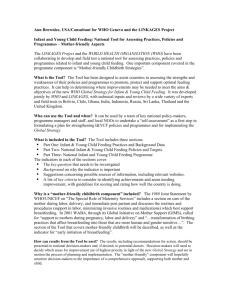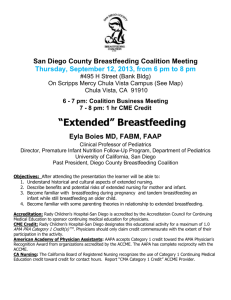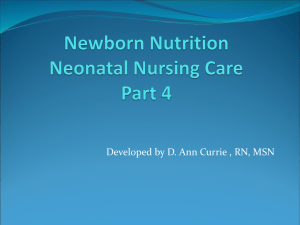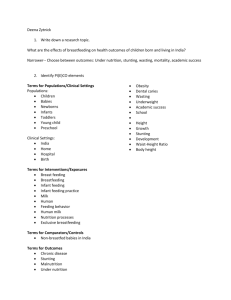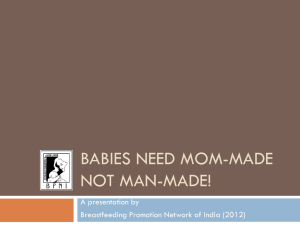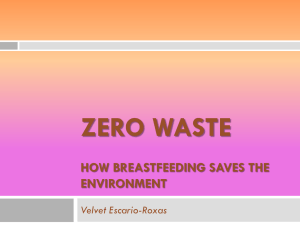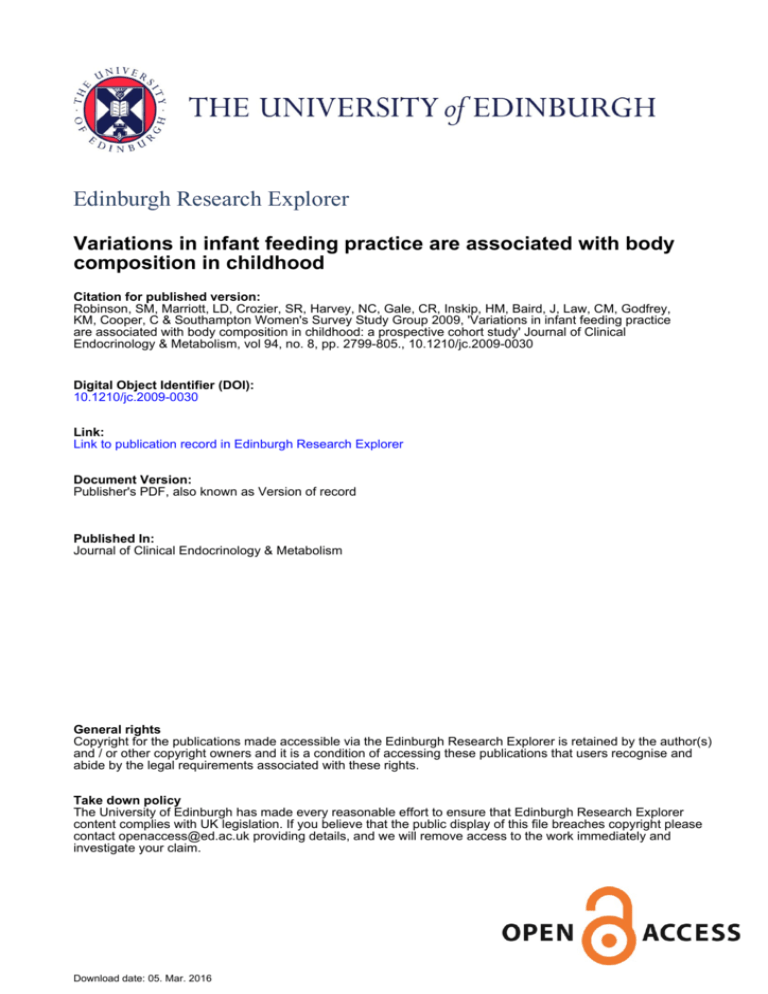
Edinburgh Research Explorer
Variations in infant feeding practice are associated with body
composition in childhood
Citation for published version:
Robinson, SM, Marriott, LD, Crozier, SR, Harvey, NC, Gale, CR, Inskip, HM, Baird, J, Law, CM, Godfrey,
KM, Cooper, C & Southampton Women's Survey Study Group 2009, 'Variations in infant feeding practice
are associated with body composition in childhood: a prospective cohort study' Journal of Clinical
Endocrinology & Metabolism, vol 94, no. 8, pp. 2799-805., 10.1210/jc.2009-0030
Digital Object Identifier (DOI):
10.1210/jc.2009-0030
Link:
Link to publication record in Edinburgh Research Explorer
Document Version:
Publisher's PDF, also known as Version of record
Published In:
Journal of Clinical Endocrinology & Metabolism
General rights
Copyright for the publications made accessible via the Edinburgh Research Explorer is retained by the author(s)
and / or other copyright owners and it is a condition of accessing these publications that users recognise and
abide by the legal requirements associated with these rights.
Take down policy
The University of Edinburgh has made every reasonable effort to ensure that Edinburgh Research Explorer
content complies with UK legislation. If you believe that the public display of this file breaches copyright please
contact openaccess@ed.ac.uk providing details, and we will remove access to the work immediately and
investigate your claim.
Download date: 05. Mar. 2016
ORIGINAL
ARTICLE
E n d o c r i n e
C a r e
Variations in Infant Feeding Practice Are Associated
with Body Composition in Childhood: A Prospective
Cohort Study
Siân M. Robinson, Lynne D. Marriott, Sarah R. Crozier, Nick C. Harvey, Catharine R. Gale,
Hazel M. Inskip, Janis Baird, Catherine M. Law, Keith M. Godfrey, Cyrus Cooper, and
Southampton Women’s Survey Study Group
Medical Research Council Epidemiology Resource Centre (S.M.R., L.D.M., S.R.C., N.C.H., C.R.G., H.M.I., J.B., K.M.G., C.C.),
University of Southampton, Southampton SO16 6YD, United Kingdom; and Centre for Paediatric Epidemiology
and Biostatistics (C.M.L.), Institute of Child Health, University College London, WC1N 1EH London, United
Kingdom
Context: Most studies of infant diet and later body composition focus on milk feeding; few consider
the influence of variations in the weaning diet.
Objective: Our objective was to examine how variations in milk feeding and the weaning diet relate
to body composition at 4 yr.
Study Population: A total of 536 children participating in a prospective birth cohort study.
Design: Diet was assessed at 6 and 12 months of age. Compliance with weaning guidance was
defined by the infant’s score for a principal component analysis-defined dietary pattern (infant
guidelines) at 12 months. Infants with high infant guidelines scores had diets characterized by high
consumption of fruit, vegetables, and home-prepared foods. Body composition was assessed at 4
yr by dual x-ray absorptiometry.
Results: Longer duration of breastfeeding was associated with lower fat mass at 4 yr 关4.5 kg, 95%
confidence interval (CI) of 4.3– 4.7 kg, in children breastfed for 12 months or more, compared with
5.0 (95% CI 4.7–5.3) kg in children never breastfed (P ⫽ 0.002)兴 but was not related to body mass
index. Children with high infant guidelines scores had a higher lean mass 关12.6 (95% CI 12.3–12.9)
kg in children in the top quarter of the distribution, compared with 12.0 (95% CI 11.7–12.4) kg in
children in the bottom quarter (P ⫽ 0.001)兴. These associations were independent and were little
changed by adjustment for confounding factors.
Conclusions: These data suggest that variations in both milk feeding and in the weaning diet are
linked to differences in growth and development, and they have independent influences on body
composition in early childhood. (J Clin Endocrinol Metab 94: 2799 –2805, 2009)
T
he dramatic rise in the prevalence of obesity in children has
focused attention on critical periods in the life course when
risk of obesity is increased and when public health interventions
may be effective in preventing excess weight gain (1). Infancy is
a period of rapid growth and gain in adiposity (2), and a number
of studies have examined the link between milk feeding in infancy
and risk of obesity at later ages (3–5).
There is some evidence that longer duration of breastfeeding
is associated with a lower body mass index (BMI) (6), although
the effects on mean BMI are generally small, and this association
is not evident in all studies (7, 8). Evidence of a protective effect
of breastfeeding is more consistent when considering overweight
(3–5, 9) and an inverse dose-response relationship with longer
duration of breastfeeding described in some studies (4, 5) sug-
ISSN Print 0021-972X ISSN Online 1945-7197
Printed in U.S.A.
Copyright © 2009 by The Endocrine Society
doi: 10.1210/jc.2009-0030 Received January 6, 2009. Accepted May 5, 2009.
First Published Online May 12, 2009
Abbreviations: BMI, Body mass index; DXA, dual x-ray absorptiometry; FFQ, food frequency questionnaire; IQR, interquartile range; PCA, principal component analysis; SWS,
Southampton Women’s Survey.
J Clin Endocrinol Metab, August 2009, 94(8):2799 –2805
jcem.endojournals.org
The Endocrine Society. Downloaded from press.endocrine.org by [${individualUser.displayName}] on 22 January 2014. at 07:15 For personal use only. No other uses without permission. . All rights reserved.
2799
2800
Robinson et al.
Infant Diet and Child Body Composition
gests that it could play a significant role in the prevention of later
obesity. However, many of these studies are limited by their
ability to consider the role of confounding influences (7) because
the choice to breastfeed may be associated with less obesogenic
family characteristics such as higher levels of education and
lower prevalence of obesity in the parents (10, 11). In studies that
have taken account of the effects of such confounding factors, the
inverse associations described between breastfeeding and later
obesity are markedly reduced (3).
BMI is a surrogate marker for adiposity, and only a few studies have examined relationships between direct measures of adiposity in childhood, determined by dual x-ray absorptiometry
(DXA), and milk feeding in infancy (10, 12–14). Of three small
studies, two found inverse but nonsignificant associations between duration of breastfeeding and adiposity (12, 13), whereas
in the third, an inverse association was described among girls but
not boys (14). In a larger study of 4325 children aged 9 –10 yr
(10), an inverse association between duration of breastfeeding
and fat mass was found. This was attenuated, but not removed,
by adjustment for confounding factors. Although the authors
concluded that confounding may explain inverse associations
between breastfeeding and adiposity in childhood, they also suggested that breastfeeding could have protective effects if maintained for more than 6 months.
A confounding influence that is rarely considered in relation
to the association between breastfeeding and later obesity is the
nature of the weaning diet (13). Factors that relate to the duration of breastfeeding, such as maternal education, also influence
the age when solid foods are introduced (15) and the types of
solid foods fed during weaning (15–17). Both milk feeding and
variations in the weaning diet should therefore be considered
when examining the influence of infant diet on later body composition (13).
We describe the associations between infant feeding and body
composition, determined using DXA, in a group of 536 children
studied at the age of 4 yr, who were born to women in a prospective birth cohort study (18). Using data collected when the
children were aged 6 and 12 months, we consider relationships
between the duration of breastfeeding and compliance with
weaning guidance, with fat mass and lean mass at 4 yr of age.
Subjects and Methods
Southampton Women’s Survey
Between 1998 and 2002, all nonpregnant women in Southampton,
UK, aged 20 –34 yr, who were registered with a general practitioner were
invited to take part in a large prospective study, the Southampton Women’s Survey (SWS). A total of 12,583 women were recruited to the study
(18). Trained research nurses visited each woman at home, when detailed
information about health and lifestyle was collected, and anthropometric measurements were taken. Women in the SWS who became pregnant
were studied throughout their pregnancy; their children are being followed up in infancy and in early childhood.
Approval for all components of the SWS was given by Southampton
and South West Hampshire Local Research Ethics Committee.
J Clin Endocrinol Metab, August 2009, 94(8):2799 –2805
Maternal and infant data
Details of mother’s age and educational attainment were obtained at
the prepregnant interview, and height and weight were measured. Educational attainment was defined in six groups according to the woman’s
highest academic qualification; social class was defined according to the
woman’s most recent occupation. Mother’s smoking status in late pregnancy was ascertained at interview at around 34 wk gestation.
The infants were visited within 2 wk of their 6-month birthday and
within a period 2 wk before and 3 wk after their 12-month birthday.
Details of the milk feeding history over the preceding 6 months were
recorded for all infants at the 6- and 12-month visits. Duration of breastfeeding was defined according to the date of the last breastfeed. Diet was
assessed using a food frequency questionnaire (FFQ) that was administered by trained research nurses to record the average frequency of consumption of the listed foods over the month preceding the home visit
(16). The age at which solid foods were introduced into the infant’s diet
was recorded. We define weaning as the period of transition in infancy
between a diet based on milk feeding to one based on solid foods.
The dietary patterns of infants in the SWS were identified using principal component analysis (PCA) (16, 19). Before the PCA of the 12month FFQ data, the foods listed on the FFQ were grouped on the basis
of similarity of type of food and nutrient composition; a total of 56 food
groups were entered into the PCA. The most important dietary pattern
(that explained the greatest variance, 7%) at 12 months of age was
characterized by a high consumption of fruit, vegetables, cooked meat
and fish, and other home-prepared foods such as rice and pasta, but by
low consumption of commercial baby foods. Because this pattern of
feeding is consistent with weaning guidance (20), we called it the infant
guidelines dietary pattern (16). An infant guidelines score was calculated
for every infant using the coefficients for each food group (defined by the
PCA) and the infant’s reported frequency of consumption of that group.
These values were summed to provide a single score for the infant that
indicated their compliance with the pattern. For example, infants with
infant guidelines scores in the top quarter of the distribution had a high
consumption of fruit (median ⫽ 13.5 portions/wk) and vegetables (median ⫽ 15.5 portions/wk), when compared with infants who had scores
in the bottom quarter (median consumption of fruit ⫽ 3.5 portions/wk;
median consumption of vegetables⫽ 5 portions/wk) (data unpublished).
Body composition assessment at 4 yr
There were 1195 singleton live births to women in the SWS between
January 2000 and December 2002. Of these, 782 children were followed
up at the age of 4 yr (January 2004 to January 2007), and invited to attend
Southampton General Hospital for an assessment of body composition
by DXA. A total of 569 children (73%) attended a clinic for the DXA
scan. The child’s height (using a portable stadiometer, Leicester height
measurer) and weight in underwear (using calibrated digital scales; Seca
Ltd., Hamburg, Germany) were measured. A list of weights for standard
items of clothing was available to adjust the weight for those children
who were not willing to undress. Body composition at 4 yr was assessed
using a Hologic 4500 Discovery W instrument (Hologic Inc., Bedford,
MA), which has a fan beam design. Total and proportionate bone, fat,
and fat-free (lean) mass were derived from a whole-body scan, using
pediatric software (version 12.7.3). The total x-ray dose for the wholebody scans was 4.7 Sv.
A total of 539 children (69%) had complete whole-body DXA measurements at 4 yr. Because fat mass and lean mass are dependent on
height, height-adjusted indices were calculated (21). We used height
raised to the power of 2 to calculate fat mass index 关fat mass (kilograms)/
height (meters)2兴, and height raised to the power of 2.5 to calculate lean
mass index 关lean mass (kilograms)/ height (meters)2.5兴. Regression of
these indices against height at 4 yr confirmed that they were not associated with height (r ⫽ ⫺0.04; P ⫽ 0.42 for fat mass index; r ⫽ 0.02; P ⫽
0.66 for lean mass index). Three children did not have measurements of
height at 4 yr and were excluded from the analyses. Our analyses are
based on 536 children (69%) who had complete body composition measurements at 4 yr.
The Endocrine Society. Downloaded from press.endocrine.org by [${individualUser.displayName}] on 22 January 2014. at 07:15 For personal use only. No other uses without permission. . All rights reserved.
J Clin Endocrinol Metab, August 2009, 94(8):2799 –2805
jcem.endojournals.org
2801
TABLE 1. Characteristics of the SWS mothers and children
Children with DXA measurements at 4 yr
(n ⴝ 536)
Mothers
Height (cm)
Age (yr)c
BMI before pregnancy (kg/m2)
Educational attainment
Lower than A-levelsd
A-levels or higher
Smoked in late pregnancy
No
Yes
Infants
Birth weight (g)
Boys
Girls
Age at introduction of solid foods
Up to 3 months
Up to 4 months
Up to 5 months
⬎5 months
Duration of breastfeeding
Never breastfed
⬍1 month
1–3 months
4 – 6 months
7–11 months
ⱖ12 months
a
Children without DXA measurements
(n ⴝ 659)
na
Meanb
SD
na
Meanb
SD
532
536
531
163.5
30.2
24.2 (median)
6.6
3.7
22.1–27.5 (IQR)
658
659
656
162.6
29.6
23.9 (median)
6.3
3.9
21.7–27.1 (IQR)
203
333
37.9%
62.2%
324
334
49.2%
50.8%
452
63
87.8%
12.2%
492
133
78.7%
21.3%
277
251
3538
3396
515
564
336
318
3444
3292
65
344
112
14
12.1%
64.3%
20.9%
2.6%
84
386
140
10
13.6%
62.3%
22.6%
1.6%
67
111
99
107
80
71
12.5%
20.8%
18.5%
20.0%
15.0%
13.3%
159
117
119
71
87
58
26.0%
19.2%
19.5%
11.6%
14.2%
9.5%
616
617
Includes some missing values.
b
Mean unless otherwise noted.
c
At birth of child.
d
Advanced Level General Certificate of Education exams taken at age 18 yr.
Statistical analysis
Statistical analysis was performed in Stata 10.1 (StataCorp,
College Station, TX). Continuous outcome variables were transformed to normality where necessary. Continuous variables were
compared between two groups using t tests, and associations between
two categorical variables were assessed using 2 tests. Pearson’s correlation coefficients were used to assess association between two continuous variables, and multivariate analysis was performed using linear regression. Summary statistics of skewed variables are given as
medians and interquartile ranges (IQR). We examined univariate associations between infant feeding variables and measures of body
composition at 4 yr, and we also considered these associations after
taking account of a number of confounding influences: maternal age,
BMI, height, education, social class, smoking in late pregnancy, infant
birth weight, and age of introduction of solid foods. The pattern
scores were divided into quartiles for presentation purposes (see Table
4 and Fig. 1).
Results
Characteristics of study population
Characteristics of the 536 children and their mothers are
shown in Table 1. Median duration of breastfeeding was 15.0 wk
(IQR 2.0 –32.4 wk), and solids were introduced at a median age
of 17.4 wk (IQR 15.0 –17.4 wk). The birth weights of boys were
higher than those of the girls (P ⫽ 0.003), and boys were intro-
duced to solid foods slightly earlier (16.5 vs. 17.1 wk, P ⫽ 0.02).
Duration of breastfeeding and the maternal characteristics
shown in Table 1 did not differ between the boys and girls. When
compared with mothers of children who were born between January 2000 and December 2002 but who did not have a DXA scan
(Table 1), the mothers of the children studied were of similar BMI
but tended to be older (P ⫽ 0.003) and taller (P ⫽ 0.02), to have
a higher level of educational attainment (P ⬍ 0.001), to breastfeed for longer (P ⬍ 0.001), and to be less likely to smoke in late
pregnancy (P ⬍ 0.001). There was no difference in the age at
introduction of solid foods between the children with and without DXA scans.
Table 2 shows the anthropometric characteristics of the children who had DXA measurements when they were 4 yr old.
According to the International Obesity Task Force categorization of BMI (22), 84% of the children were of normal BMI at 4
yr, 13% were overweight, and 3% were obese. There was a
tendency for the boys to be slightly taller (P ⫽ 0.062) than the
girls, but weight and BMI did not differ (P ⫽ 0.25 and 0.75,
respectively). Boys had a higher lean mass and lean mass index
compared with the girls (both P ⬍ 0.001), but a lower fat mass
and fat mass index (both P ⬍ 0.001). Body composition measurements were therefore adjusted for sex before subsequent
analyses.
The Endocrine Society. Downloaded from press.endocrine.org by [${individualUser.displayName}] on 22 January 2014. at 07:15 For personal use only. No other uses without permission. . All rights reserved.
2802
Robinson et al.
Infant Diet and Child Body Composition
J Clin Endocrinol Metab, August 2009, 94(8):2799 –2805
Fat mass index and lean mass index calculated to be independent of height
at 4 yr.
Relationship between weaning diet and body
composition
There was a weak inverse association between fat mass at 4
yr and age at introduction of solid foods (P ⫽ 0.034), but this
association was not seen after adjustment for confounding factors. BMI, fat mass index, lean mass, and lean mass index were
not related to age at introduction of solid foods (data not shown).
Table 4 shows the associations between infant guidelines dietary
pattern scores at 12 months and measures of body composition
at 4 yr. There were no associations between infant guidelines
scores and BMI, fat mass, or fat mass index at 4 yr, but lean mass
and lean mass index were positively associated with the infant
guidelines score, such that infants fed in accordance with weaning recommendations who were given a diet based on fruit, vegetables, cooked meat and fish, and other home-prepared foods
had a higher lean mass at 4 yr. This association was not changed
by adjustment for confounding factors.
Relationship between breastfeeding duration and body
composition
The associations between the duration of breastfeeding and
measures of body composition at 4 yr are shown in Table 3. BMI
and lean mass did not vary in relation to the duration of breastfeeding, although after adjusting for the influence of potential
confounding factors (maternal age, BMI, height, education, social class, smoking in late pregnancy, infant birth weight, and age
of introduction of solid foods), there was a tendency for the lean
mass index to be higher among the children who were breastfed
for longer. There were graded inverse associations between duration of breastfeeding and fat mass and fat mass index, such that
infants who were breastfed for longer had a lower fat mass at 4
yr. These associations were still evident after taking account of
potential confounding factors. Because breastfeeding may be
more strongly related to overweight than to mean BMI (6), we
also considered the 87 children defined as overweight or obese
according to the International Obesity Task Force cutoffs (22).
Breastfeeding duration was shorter among these children 关median duration 8.7 wk (IQR 0.7–23.7 wk)兴 in the overweight or
obese group compared with the remaining 449 children 关median
duration 17.4 wk (IQR 2.2–34.8 wk); P ⫽ 0.031兴.
Combined influences of breastfeeding and the weaning
diet on body composition
Because infants who were fed in accordance with weaning
guidance were more likely to have been breastfed for longer
(correlation between duration of breastfeeding and infant
guidelines scores at 12 months r ⫽ 0.16; P ⬍ 0.001), we used
a combined model that included both infant feeding variables
together with the confounding factors (maternal age, BMI,
height, education, social class, smoking in late pregnancy,
infant birth weight, and age of introduction of solid foods) to
examine their independent influences on body composition at
4 yr. The relationships between breastfeeding duration and
both fat mass and fat mass index at 4 yr were little changed by
taking account of infant guidelines scores at 12 months (both
P ⬍ 0.01). Similarly, taking account of breastfeeding duration
had little effect on the associations between infant guidelines
score and lean mass or lean mass index (both P ⬍ 0.02). Figure
1 shows fat mass, lean mass, and the derived indices (adjusted
for the effects of confounding influences) according to breastfeeding duration in the first year and infant guidelines score at
12 months. The full models explained 10.1% of the variance
TABLE 2. Anthropometric characteristics of the children
studied at 4 yr
Boys (n ⴝ 283)
Height (cm)
Weight (kg)
BMI (kg/m2)a
Lean mass (kg)
Lean mass index
(kg/m2.5)b
Fat mass (kg)a
Fat mass index
(kg/m2)a,b
Girls (n ⴝ 253)
Mean
95% CI
Mean
95% CI
104.2
17.6
16.1
12.9
12.2
103.8 –104.6
17.3–17.8
16.0 –16.3
12.8 –13.1
12.1–12.3
103.5
17.4
16.1
11.9
11.4
103.0 –104.1
17.1–17.7
15.9 –16.3
11.7–12.1
11.3–11.5
4.3
4.0
4.2– 4.4
3.9 – 4.1
5.0
4.6
4.8 –5.1
4.5– 4.8
CI, Confidence interval.
a
Geometric means.
b
TABLE 3. Associations between duration of breastfeeding in infancy and body composition at 4 yra
Mean (95% CI)
Duration of breastfeeding
Never breastfed
⬍1 month
1–3 months
4 – 6 months
7–11 months
12 or more months
P for trendc
P for trend (adjusted)c,d
a
BMI (kg/m2)b
Lean mass (kg)
Lean mass index
(kg/m2.5)
Fat mass (kg)b
Fat mass index
(kg/m2)b
16.4 (16.1–16.8)
16.2 (15.9 –16.5)
16.2 (15.9 –16.4)
15.8 (15.5–16.0)
16.1 (15.8 –16.4)
16.1 (15.8 –16.3)
0.059
0.171
12.4 (12.0 –12.9)
12.4 (12.2–12.7)
12.4 (12.1–12.7)
12.2 (11.9 –12.5)
12.7 (12.4 –13.1)
12.6 (12.2–12.9)
0.383
0.961
11.8 (11.5–12.0)
11.8 (11.7–12.0)
11.8 (11.7–12.0)
11.8 (11.6 –11.9)
11.9 (11.7–12.1)
11.9 (11.8 –12.1)
0.213
0.041
5.0 (4.7–5.3)
4.7 (4.5– 4.9)
4.7 (4.5– 4.9)
4.3 (4.2– 4.5)
4.6 (4.3– 4.8)
4.5 (4.3– 4.7)
0.002
0.004
4.6 (4.4 – 4.9)
4.4 (4.2– 4.6)
4.3 (4.2– 4.5)
4.1 (3.9 – 4.2)
4.2 (4.0 – 4.4)
4.2 (4.0 – 4.4)
0.001
0.015
All values were adjusted for sex.
b
Geometric means.
c
From linear regression analysis.
d
Adjusted for maternal age, BMI, height, education, social class, smoking in late pregnancy, infant birth weight, and age of introduction of solid foods.
The Endocrine Society. Downloaded from press.endocrine.org by [${individualUser.displayName}] on 22 January 2014. at 07:15 For personal use only. No other uses without permission. . All rights reserved.
J Clin Endocrinol Metab, August 2009, 94(8):2799 –2805
jcem.endojournals.org
2803
TABLE 4. Associations between infant guidelines dietary pattern scores at 12 months and body composition at 4 yra
Mean (95% CI)
Infant guidelines score
⬍⫺0.68
⫺0.68 – 0
0 – 0.68
⬍0.68
P for trendc
P for trend (adjusted)c,d
a
BMI (kg/m2)b
Lean mass (kg)
Lean mass index
(kg/m2.5)
15.9 (15.6 –16.1)
16.1 (15.8 –16.3)
16.2 (16.0 –16.5)
16.1 (15.8 –16.3)
0.205
0.102
12.0 (11.7–12.4)
12.3 (12.1–12.6)
12.7 (12.4 –12.9)
12.6 (12.3–12.9)
0.001
0.003
11.7 (11.5–11.9)
11.8 (11.6 –11.9)
11.9 (11.8 –12.0)
11.9 (11.8 –12.1)
0.011
0.004
Fat mass (kg)b
Fat mass index
(kg/m2)b
4.5 (4.3– 4.7)
4.7 (4.5– 4.9)
4.7 (4.5– 4.9)
4.5 (4.3– 4.6)
0.609
0.781
4.3 (4.1– 4.4)
4.3 (4.2– 4.5)
4.3 (4.2– 4.5)
4.1 (4.0 – 4.3)
0.166
0.488
All values were adjusted for sex.
b
Geometric means.
c
From linear regression analysis.
d
Adjusted for maternal age, BMI, height, education, social class, smoking in late pregnancy, infant birth weight, and age of introduction of solid foods.
We have shown that variations in infant feeding, both in milk
feeding and in the quality of the weaning diet, are associated with
differences in body composition determined using DXA at the
age of 4 yr. Longer duration of breastfeeding was strongly associated with a lower fat mass. Independently of the duration of
breastfeeding, infants fed a diet based on fruit, vegetables, and
home-prepared foods during weaning had a higher lean mass at
4 yr. These effects of breastfeeding and the weaning diet were
independent of child’s height at 4 yr and remained after taking
Strengths and weaknesses
The children we studied were born to women in the SWS, a
general population sample of women and their children living in
Southampton, from a wide range of sociodemographic backgrounds (18). The children were visited by trained research
nurses at 6 and 12 months of age, when contemporary information on milk feeding and diet was obtained. This should minimize
any effect of recall bias that may influence retrospective reports
of infant feeding if determined at later ages. Diet was assessed
13
r = 0.14
P = 0.003
Lean mass (kg)
12.8
12.6
12.4
12.2
12
Lean mass index (kg/m2.5)
Discussion
account of a range of confounding influences. An effect of the
weaning diet on later body composition assessed by DXA has not
been described before. There were no associations between variations in infant diet and mean BMI at 4 yr, although overweight
and obese children tended to be breastfed for a shorter period.
in fat mass (fat mass index, 6.7%) and 21.3% of the variance
in lean mass (lean mass index, 5.5%).
12.2
r = 0.13
P = 0.005
12
11.8
11.6
11.8
11.6
11.4
5.5
r = -0.12
P = 0.01
Fat mass (kg)
5
4.5
4
< -0.68
<0
< 0.68
> 0.68
‘Infant guidelines’ score at 12 months (SDs)
Fat mass index (kg/m2)
< -0.68
<0
< 0.68
> 0.68
‘Infant guidelines’ score at 12 months (SDs)
5
r = -0.10
P = 0.04
4.8
4.6
4.4
4.2
4
3.5
3.8
Never
<1
1 to 3 4 to 6 7 to 11 12 or more
Completed months breastfeeding
Never
<1
1 to 3 4 to 6 7 to 11 12 or more
Completed months breastfeeding
FIG. 1. Body composition at 4 yr according to duration of breastfeeding in infancy and infant guidelines score at 12 months of age. All values were adjusted for
maternal age, BMI, height, education, social class, smoking in late pregnancy, infant birth weight, and age of introduction of solid foods. Lean mass and lean mass
index were also adjusted for breastfeeding duration, and fat mass and fat mass index were also adjusted for infant guidelines score at 12 months.
The Endocrine Society. Downloaded from press.endocrine.org by [${individualUser.displayName}] on 22 January 2014. at 07:15 For personal use only. No other uses without permission. . All rights reserved.
2804
Robinson et al.
Infant Diet and Child Body Composition
using FFQs that were administered by trained research nurses.
Although there is concern that FFQs can be prone to measurement error (23), they have been shown to identify similar
patterns of diet as other dietary methods, and dietary pattern
scores determined using different dietary methods are highly
correlated (16, 24).
A strength of our study is that we used DXA to assess body
composition, which provided direct measures of fat mass and
lean mass, and we also considered fat and lean mass indices that
were independent of the child’s height. Using BMI as a surrogate
measure of adiposity, we saw no relationships with the duration
of breastfeeding, whereas there were strong associations with
DXA-assessed fat mass at 4 yr. The lack of association with BMI
is consistent with the findings of the PROBIT trial (7) and indicates that BMI may be of limited use as a measure of adiposity in
early childhood (25). A weakness of our study is that we did not
approach all the children in the SWS cohort and that 31% of the
children approached did not have a DXA scan. Although the
mothers of the children studied tended to have higher levels of
educational attainment and to breastfeed for longer than other
mothers in the SWS, the children studied came from a wide range
of backgrounds. Unless the associations were different in the
remainder of the cohort, it is unlikely that selection bias could
explain the relationships between infant feeding and body composition that we observed. When we took account of the effects
of a number of confounding influences, most notably maternal
BMI, which has been shown to be associated with the offspring’s
adiposity (14), we found that the adjustments made little difference to the associations with body composition (Tables 3 and 4).
Breastfeeding and body composition in childhood
We found a graded association between breastfeeding duration and DXA-assessed fat mass, which was little changed after
taking account of a range of maternal factors, infant birth
weight, age of introduction of solid foods, and the infant guidelines pattern score. In contrast, Burdette et al. (13) found no
significant difference in fat mass among 313 children aged 5 yr
in relation to breastfeeding duration, although there was a tendency for fat mass to be lower among the children who were
breastfed. These differing findings may be due to differences in
statistical power but could also be explained by differences in the
assessment of breastfeeding, which in their study, was reported
when the children were aged 3 yr (13). Our findings of lower
DXA-assessed fat mass in relation to longer duration of breastfeeding are comparable to those of Toschke et al. (10). However,
our conclusions differ. Although we cannot exclude the possibility that longer duration of breastfeeding is acting as a marker
of less obesogenic family characteristics (10, 11), we do not think
the associations we observed are largely explained by confounding influences.
Weaning diet and body composition in childhood
We found that infants who were fed according to infant feeding recommendations and who were provided with a diet based
on fruit, vegetables, meat and fish, and other home-prepared
foods such as rice and pasta during weaning had a higher lean
mass at 4 yr. These associations were not explained by maternal
J Clin Endocrinol Metab, August 2009, 94(8):2799 –2805
height, BMI, education, or smoking status in pregnancy and were
independent of infant birth weight, the age of introduction of
solid foods, and the height of the child at 4 yr. Although the
choice to breastfeed and the duration of breastfeeding are socially patterned, and the diets of breastfed and formula-fed infants may differ (17), the association between the infant guidelines dietary pattern score and later body composition we
observed was independent of duration of breastfeeding. We did
not find any associations between variation in the weaning diet
and adiposity at 4 yr. We have previously reported greater gains
in skinfold thickness between 6 and 12 months among infants fed
according to weaning guidance at 6 months of age, although gain
in skinfold thickness was not associated with their dietary pattern at 12 months (26). One possible explanation for the association seen at 6 months is that there are small short-term differences in adiposity among infants with different early weaning
diets that do not persist beyond infancy. This highlights the need
to examine associations between infant diet and body composition in children at older ages (26).
The mechanisms linking variations in the weaning diet to a
greater lean mass in childhood are unknown, and we do not
know whether individual compartments of lean mass are affected equally. One possibility is that the quality of the infant diet
is indicative of the quality of the diet provided in the following
years and that a diet characterized by fruit, vegetables, and homeprepared foods provided throughout early childhood allows
greater growth in lean mass. This might be expected because
tracking of dietary patterns in infancy and in early childhood has
been described (16, 27), and we would predict that the nature of
the diet provided to SWS infants at 12 months would be similar
to their childhood diet. A second possibility is that families that
provide an infant diet that conforms to recommendations have
other characteristics that could affect growth and development
in early childhood. Families vary in their obesogenic characteristics, notably in levels of dietary intake and physical activity
(28). It is possible that higher infant guidelines scores are indicative of other behavioral differences (29) including higher levels
of physical activity in childhood and that these differences have
effects on growth and development.
In conclusion, our data show that adherence to current recommendations to breastfeed and to provide a weaning diet based
on fruit, vegetables, and home-prepared foods is associated with
a higher lean mass and a lower fat mass at 4 yr of age. Although
with so few studies of DXA-assessed body composition in
childhood to date so that the long-term consequences of the
differences described at 4 yr may be uncertain, these observational findings provide some support for existing infant
feeding guidance.
Acknowledgments
We thank the families who took part in the Southampton Women’s
Survey (SWS), the SWS research staff, and Vanessa Cox and Patsy Coakley
who managed the data.
Address all correspondence and requests for reprints to: Siân Robinson,
Medical Research Council Epidemiology Resource Centre, University of
The Endocrine Society. Downloaded from press.endocrine.org by [${individualUser.displayName}] on 22 January 2014. at 07:15 For personal use only. No other uses without permission. . All rights reserved.
J Clin Endocrinol Metab, August 2009, 94(8):2799 –2805
Southampton, Southampton General Hospital, Southampton SO16 6YD,
United Kingdom. E-mail: smr@mrc.soton.ac.uk.
This work was supported by the Medical Research Council, University of Southampton, British Heart Foundation, and the Food Standards
Agency (contract NO5049).
Disclosure Summary: The authors have nothing to disclose.
References
1. Dietz WH 2004 Overweight in childhood and adolescence. N Engl J Med
350:855– 857
2. Stettler N 2007 Nature and strength of epidemiological evidence for origins of
childhood and adulthood obesity in the first year of life. Int J Obes 31:1035–
1043
3. Owen CG, Martin RM, Whincup PH, Smith GD, Cook DG 2005 Effect of
infant feeding on the risk of obesity across the life course: a quantitative review
of published evidence. Pediatrics 115:1367–1377
4. Arenz S, Ruckerl R, Koletzko B, von Kries R 2004 Breast-feeding and childhood obesity: a systematic review. Int J Obes 28:1247–1256
5. Harder T, Bergmann R, Kallischnigg G, Plagemann A 2005 Duration of breastfeeding and risk of overweight: a meta-analysis. Am J Epidemiol 162:397– 403
6. Owen CG, Martin RM, Whincup PH, Davey-Smith G, Gillman MW, Cook
DG 2005 The effect of breastfeeding on mean body mass index throughout life:
a quantitative review of published and unpublished observational evidence.
Am J Clin Nutr 82:1298 –1307
7. Kramer MS, Matush L, Vanilovich I, Platt RW, Bogdanovich N, Sevkovskaya
Z, Dzikovich I, Shishko G, Collet JP, Martin RM, Davey Smith G, Gillman
MW, Chalmers B, Hodnett E, Shapiro S; PROBIT Study Group 2007 Effects
of prolonged and exclusive breastfeeding on child height, weight, adiposity and
blood pressure at age 6.5y: evidence from a large randomized trial. Am J Clin
Nutr 86:1717–1721
8. Michels KB, Willett WC, Graubard BI, Vaidya RL, Cantwell MM, Sansbury
LB, Forman MR 2007 A longitudinal study of infant feeding and obesity
throughout life course. Int J Obes 31:1078 –1085
9. Bergmann KE, Bergmann RL, von Kries R, Bohm O, Richter R, Dudenhausen
JW, Wahn U 2003 Early determinants of childhood overweight and adiposity
in a birth cohort study: role of breast-feeding. Int J Obes 27:162–172
10. Toschke AM, Martin RM, von Kries R, Wells J, Smith GD, Ness AR 2007
Infant feeding method and obesity: body mass index and dual x-ray absorptiometry measurements at 9 –10 y of age from the Avon Longitudinal Study of
Parents and Children (ALSPAC). Am J Clin Nutr 85:1578 –1585
11. Oddy WH, Li J, Landsborough L, Kendall GE, Henderson S, Downie J 2006
The association of maternal overweight and obesity with breastfeeding duration. J Pediatr 149:185–191
12. Tulldahl J, Pettersson K, Andersson SW, HulthénL 1999 Mode of infant feeding and achieved growth in adolescence: early feeding patterns in relation to
growth and body composition in adolescence. Obes Res 7:431– 437
jcem.endojournals.org
2805
13. Burdette HL, Whitaker RC, Hall WC, Daniels SR 2006 Breastfeeding, introduction of complementary foods, and adiposity at 5y of age. Am J Clin Nutr
83:550 –558
14. Gale CR, Javaid MK, Robinson SM, Law CM, Godfrey KM, Cooper C 2007
Maternal size in pregnancy and body composition in children. J Clin Endocrinol Metab 92:3904 –3911
15. Bolling K, Grant C, Hamlyn B, Thornton A 2007 Infant feeding survey 2005.
NHS, The Information Centre for health and social care. http://www.ic.nhs.uk/
statistics-and-data-collections/health-and-lifestyles-related-surveys/infantfeeding-survey/infant-feeding-survey-2005
16. Robinson S, Marriott L, Poole J, Crozier S, Borland S, Lawrence W, Law C,
Godfrey K, Cooper C, Inskip H, Southampton Women’s Survey Study Group
2007 Dietary patterns in infancy: the importance of maternal and family influences on feeding practice. Br J Nutr 98:1029 –1037
17. Noble S, Emmett P 2006 Differences in weaning practice, food and nutrient
intake between breast- and formula-fed 4-month-old infants in England. J
Hum Nutr Diet 19:303–313
18. Inskip HM, Godfrey KM, Robinson SM, Law CM, Barker DJ, Cooper C 2006
Cohort profile: the Southampton Women’s Survey. Int J Epidemiol 35:42– 48
19. Joliffe IT, Morgan BJ 1992 Principal component analysis and exploratory
factor analysis. Stat Methods Med Res 1:69 –95
20. Department of Health 2006 Birth to five. London: COI
21. Wells JC, Cole TJ; ALSPAC Study Team 2002 Adjustment of fat-free mass and
fat mass for height in children aged 8y. Int J Obes 26:947–952
22. Cole TJ, Bellizzi MC, Flegal KM, Dietz WH 2000 Establishing a standard
definition for child overweight and obesity worldwide: international survey. Br
Med J 320:1240 –1245
23. Bingham SA, Luben R, Welch A, Wareham N, Khaw KT, Day N 2003 Are
imprecise methods obscuring a relation between fat and breast cancer? Lancet
362:212–214
24. Hu FB, Rimm E, Smith-Warner SA, Feskanich D, Stampfer MJ, Ascherio A,
Sampson L, Willett WC 1999 Reproducibility and validity of dietary patterns
assessed with a food frequency questionnaire. Am J Clin Nutr 69:243–249
25. Wells JC, Fewtrell MS 2006 Measuring body composition. Arch Dis Child
91:612– 617
26. Baird J, Poole J, Robinson S, Marriott L, Godfrey K, Cooper C, Inskip H, Law
C 2008 Milk feeding and dietary patterns predict weight and fat gains in
infancy. Paediatr Perinat Epidemiol 22:575–586
27. Northstone K, Emmett P; ALSPAC Study Team 2005 Multivariate analysis of
diet in children at four and seven years of age and associations with sociodemographic characteristics. Eur J Clin Nutr 59:751–760
28. Krahnstoever Davison K, Lipps Birch L 2002 Obesigenic families: parents’
physical activity and dietary intake patterns predict girls’ risk of overweight.
Int J Obes 26:1186 –1193
29. Taveras EM, Rifas-Shiman SL, Scanlon KS, Grummer-Strawn LM, Sherry B,
Gillman MW 2006 To what extent is the protective effect of breastfeeding on
future overweight explained by decreased maternal feeding restriction? Pediatrics 118:2341–2348
The Endocrine Society. Downloaded from press.endocrine.org by [${individualUser.displayName}] on 22 January 2014. at 07:15 For personal use only. No other uses without permission. . All rights reserved.

